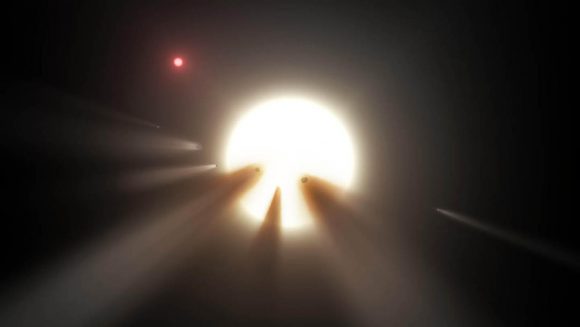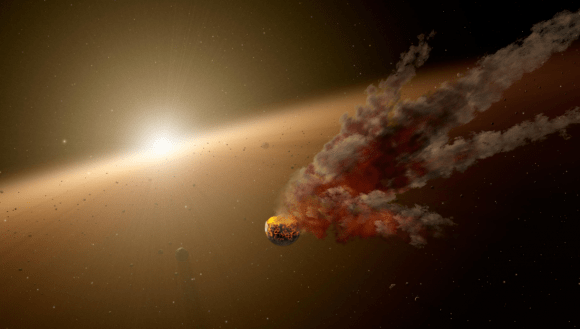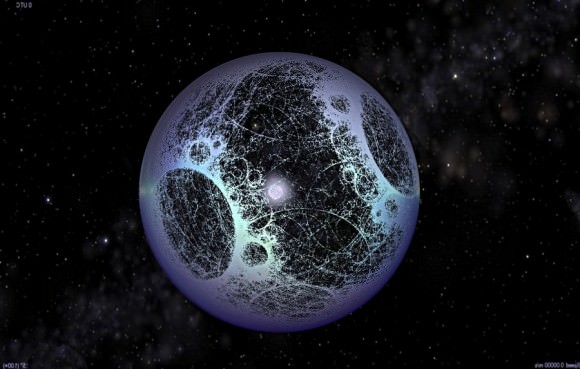
Not an Alien Megastructure, a Cloud of Dust on a 700-Day Orbit

The mystery of KIC 8462852 (aka. Boyajian’s Star or Tabby’s Star) continues to excite and intrigue! Ever since it was first seen to be undergoing strange and sudden dips in brightness (back in October of 2015) astronomers have been speculating as to what could be causing this. Since that time, various explanations have been offered, including large asteroids, a large planet, a debris disc or even an alien megastructure.
Many studies have been produced that have sought to assign some other natural explanation to the star’s behavior. The latest comes from an international team of scientists – which included Tabetha Boyajian, the lead author on the original 2016 paper. According to this latest study, which was recently published in The Astrophysical Journal, the star’s long-term dimming patterns are likely the result of an uneven dust cloud moving around the star.
The study, titled “Extinction and the Dimming of KIC 8462852“, was led by Huan Y. A. Meng of the Steward Observatory at the University of Arizona. The team also included members from the Astrolab IRIS in Belgium, the Johns Hopkins University Applied Physics Laboratory (JHUAPL), the University of Cambridge, Iowa State University, Pennsylvania State University, Louisiana State University, and the University of Leuven, Belgium.

Artist’s impression of an orbiting swarm of dusty comet fragments around Tabby’s Star. Credit: NASA/JPL-Caltech
For the sake of their study, the team consulted data that was obtained by NASA’s Spitzer Space Telescope and the Swift Gamma-Ray Burst mission between January and December of 2016. Whereas Spitzer conducted observations in the infrared band, Swift gathered data in the ultraviolet band. This was then compared to visible light gathered during the same period by AstroLAB IRIS’s 68-cm (27-inch) reflecting telescope.
What they found was that KIC 8462852 experienced less dimming in the infrared band than in the ultraviolet. This, they concluded, was a strong indication that material transiting in front of the star was likely no larger than a few micrometers (about one ten-thousands of an inch) in diameter, since anything larger would cause the light to dim equally across all wavelengths.
This finding contradicts many theories that have been ventured since the mysterious dimming of Tabby’s Star was first noticed. As Dr. Meng indicated in a recent NASA press statement:
“This pretty much rules out the alien megastructure theory, as that could not explain the wavelength-dependent dimming. We suspect, instead, there is a cloud of dust orbiting the star with a roughly 700-day orbital period.”

Artist’s concept of KIC 8462852, which has experienced unusual changes in luminosity over the past few years. Credit: NASA, JPL-Caltech
Based on the strong dip in the ultraviolet band, the research team also concluded that the particles must be larger than interstellar dust. Otherwise, the pressure caused by KIC 8462852’s solar wind would drive these particles out into space over time. A circumstellar disk of dust particles would not only be able to remain in orbit, it would also explain the uneven changes in the star’s brightness.
So far, this is the best explanation for the mysterious long-term behavior of Tabby’s Star. As with previous observations, much of the credit for this latest study goes to amateur astronomers who assisted in the observations. It was participants in the Planet Hunters project, which provides open to access Kepler mission data, that first noticed that light coming from KIC 8462852 was experiencing strange dips.
In addition, it was the work of amateur astronomers – who provided the necessary technical and software support to AstroLAB – allowed for this study to take place. After the Astrolab group posted the data they had obtained on Tabby’s star in a public astronomy archive, George Rieke (one of the co-authors on this latest study) contacted them and proposed combining their results.
The AstroLAB group consists of Franky Dubois, who operated the telescope during the Tabby’s Star observations, Ludwig Logie, who helps with technical issues on the telescope, and Steve Rau, who processes observations of star brightness, is a trainer at a Belgian railway company. Together, they began monitoring Tabby’s Star after they read Dr. Boyajian 2016 study.

Ever since it was first announced in 2015, there has been speculation as to what could account for the dimming of KIC 8462852. Credit: SentientDevelopments.com
Naturally, more observations and research is needed to confirm this latest study. While it does fit the long-term observations, there is still the matter of shorter-term dimming events. These include the three-day spurts that were noticed in 2017, as well as the major 20-percent dips that were observed during Kepler’s primary mission. The theory that these could have been the result of a swarm of comets is also still a possible explanation.
This theory, which was based on data collected by the Wide-field Infrared Survey Explorer (WISE) mission, could explain both the short period dips and the longer-term dips. Whereas the comets passing in front of the star could explain the former, dust produced by the sublimation of material from the comets as they draw nearer the star (or through collisions) could explain the latter. As Vanaverbeke said:
“Tabby’s Star could have something like a solar activity cycle. This is something that needs further investigation and will continue to interest scientists for many years to come.”
So for those hoping that Tabby’s Star was the first indication of an alien megastructure, there’s still hope (albeit a faint one)! As Professor Loeb of the Harvard Smithsonian Center for Astrophysics (CfA) told Universe Today recently (with regards to a new study he co-authored), there’s always the possibility that dimming patterns are due to massive structures – like a magnetic shield – passing in front of a host star:
“The imprint of a shield built by another civilization could involve the changes it induces in the brightness of the host star due to occultation (similar behavior to Tabby’s star) if the structure is big enough,” he said. “The situation could be similar to Dyson’s spheres, but instead of harvesting the energy of the star the purpose of the infrastructure is to protect a technological civilization on a planet from the flares of its host star.”
While the Kepler mission is no longer in a position to observe Tabby’s Star (now that it is conducting its K2 mission), next-generation telescopes are expected to pick up where it left off. These include NASA’s James Webb Space Telescope, the Wide Field Infrared Survey Telescope (WFIRST), and ground-based observatories like the Extremely Large Telescope (VLT) array.
Further Reading: NASA, The Astrophysical Journal
The post Not an Alien Megastructure, a Cloud of Dust on a 700-Day Orbit appeared first on Universe Today.
Universe Today
Go to Source
Powered by WPeMatico